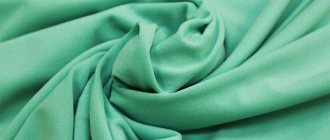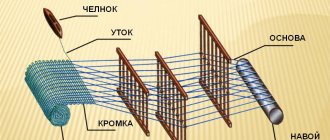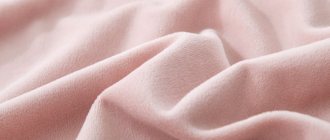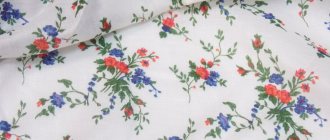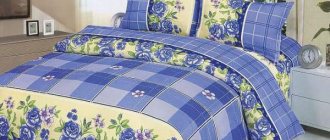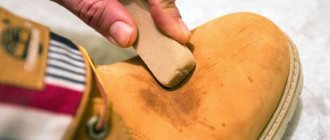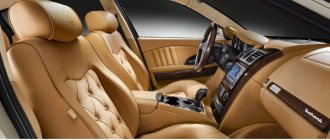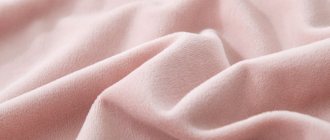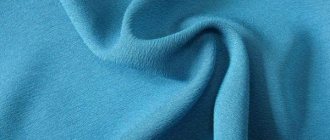Cupra (cupro) is an artificial material that is superior in quality to many natural fabrics. It is very light, soft, easy to handle and simply beautiful. The name “cupra” comes from the foreign word cupro, which means copper. What cupra fabric is – and how its name is related to copper – we will tell you in the article. And also about its properties, composition and application.
Cupro - what kind of fabric?
Cupro is not a natural fabric. Its name comes from the Latin word cuprum, which means “copper”. To make cuprous fiber, they take wood chips, cotton tow, and coconut fiber. Such raw materials contain cellulose.
The raw materials are treated with a mixture of copper sulfate and ammonia. Then the resulting mass is passed through a metal sieve. Strong and shiny threads are formed - cuprous fiber. They are treated with sulfuric acid to make them smooth, soaked and made into fabric.
Cuprofibre is added to other types of fabric to obtain new properties. It contains taffeta, viscose, artificial silk, satin, jacquard. Cupro gives other materials crease resistance and strength. Dense, non-stretchy fabrics containing cupro provide a better fit.
The colors of the material are rich in variety. It is easy to paint, the color is bright and durable. There can be either plain or patterned colors.
Types of fabric:
- tweed;
- jacquard;
- knitwear;
- atlas;
- boucle;
- velours;
- brocade.
See fabric review:
This is interesting: Fabric eraser: composition, description, care recommendations
Cupro: fabric composition and production
Cotton fluff and wood cellulose are used in the production process of cupro fiber. Coconut coir, the fiber that covers the coconut, is sometimes used. The feedstock is exposed to a copper-ammonia solution. The mass obtained in this way passes through special filters and is treated with sulfuric acid. As a result of using this technology, transparent and thin fibers are obtained, characterized by shine and smoothness. The name of the matter is directly related to the method of its creation. Translated from Latin, "cupro" means "copper".
Advantages and disadvantages
Cupra fabric is unique in structure. It is durable and elastic, light and smooth, with a soft, noble shine. The fibers are easy to dye and retain color for a long time. The thin cupra fabric is pleasant to the body, it allows air to pass freely and at the same time retains heat. Among the disadvantages of the fabric, one can note the long and complex production process, as well as the high cost. In many European countries and the USA, the production of cupra has been stopped due to the negative impact of its production processes on the environment.
Properties and Features:
- softness and smoothness;
- breathability;
- hygroscopicity;
- good thermal conductivity;
- firmness and elasticity;
- ability to drape;
- elasticity (fabric does not wrinkle);
- resistance to fading;
- thermoregulation property;
- strength in dry and wet conditions;
- thin and light;
- does not shed.
Advice! The beautiful volatility, elegant shine, close-fitting silhouette and special elasticity of cupra allow it to be used in sewing expensive evening and weekend wear - dresses, blouses, suits.
Cupra materials are comfortable to wear - in summer they pleasantly cool the body, and in winter they warm well. The fabric is used for sewing a wide variety of clothes - elite casual and elegant, as a lining for expensive outerwear - coats, jackets and fur coats.
Advantages
The material belongs to elite fabrics not only because of the high production costs. But also because it is close in its properties to natural silk. But unlike natural and most synthetic fabrics, cupro does not wrinkle.
Other advantages of the fabric:
- Hygroscopicity. The material absorbs and retains moisture well.
- Thermoregulation. It retains heat in cold weather and releases heat in hot weather.
- Breathability. The material is considered “breathable”.
The fabric is soft and delicate and comfortable to wear. It is elastic and resilient, beautifully fits the figure, but does not deform when worn.
Description and composition
The name of the fabric is a reference to its composition. Copper is actually included in the fabric. The main raw material is wood cellulose. It goes through a complex chemical and technological processing process. Thus, cupra is a rare variety of high-quality viscose. In terms of external characteristics and tactile sensations, it is close to natural silk.
Interesting fact: The discovery of cupra occurred by accident in the 20th century, when cotton crops were treated against insect pests with copper sulfate. Today it is classified as an expensive fabric with impeccable appearance and high consumer characteristics.
Acid treatment makes cellulose fiber as thin, long and transparent as possible; the admixture of copper salts in the composition gives the material strength and resistance to mechanical stress. Cotton inclusions make cupra products easier to care for and comfortable to wear.
How to choose the right care
They choose high-quality cupra based on density and appearance; products made from this fabric are expensive. Beautiful designer items require special treatment - the most gentle care possible. It is recommended to dry clean outerwear items.
Caring for cupra fabric products:
- hand wash at 30 or 40°;
- delicate machine wash;
- mild detergents with neutral PH;
- without machine spin;
- without automatic drying;
- Iron on low setting on reverse side.
Advice! It is recommended to iron cupra products only when they are completely dry. Wet fabric is quite vulnerable to heat and steam.
The products are carefully squeezed by hand: wrapped in a towel and gently pressed so that the terry cloth absorbs moisture. Then the cupra product is straightened and dried in a horizontal position, in the process protected from contact with hot air and direct sunlight. Products are stored on hangers and folded, since the material does not stretch and does not form creases.
Cupra is multifunctional in its application - clothing, casual and elegant, textiles and interior items. Things made from cupra are stylish and comfortable to wear, they are suitable for any season and different weather. High-quality cupra carpets are highly valued; they will adequately decorate a home.
How to care for products made from this fabric?
Recommendations for caring for items made from cupra depend on the fibers included in its composition. Typically, all the necessary information and warnings are indicated on the label of factory clothing models. To preserve the product as long as possible, you must follow these instructions.
Sometimes the label on things is missing or does not contain the necessary information. In this case, you need to follow the basic rules for caring for cupra products:
- the material can be washed either in a washing machine in the “silk” or “delicate fabrics” mode, or by hand;
- Before washing, you need to turn the clothes inside out and fasten all zippers and buttons to prevent mechanical damage and spoil the product;
- When washing, it is better to separate items made from cupra from other synthetic and natural materials;
- the use of detergents with chlorine and bleaches is unacceptable;
- You can wash the fabric at a temperature of 30–40 degrees;
- products should not be wrung out, as when wet, cupra loses strength and can easily become deformed;
- When drying, clothes must be straightened and kept away from direct sunlight;
- You can iron the fabric only from the wrong side, using the minimum heat setting of the iron;
- It is not recommended to steam clothes made from cupro, as this procedure can cause stains on the products;
- things can be stored folded, since the material is not subject to wrinkles.
Cupro fabric (cupra)
In its properties, cuprofibre is very similar to silk and belongs to elite and expensive materials .
Material manufacturing technology
The name cupra material comes from the Latin name for copper and is directly related to the fabric production technology, which was discovered at the beginning of the twentieth century. Various types of plants , coconut, cotton and wood, all containing cellulose, are used as raw materials for the production of artificial cupra fabric An interesting feature of the technology: in order to obtain high-quality, elastic and at the same time smooth fiber, a solution of copper sulfate and ammonia is used to process cellulose. As a result, thin but strong threads are formed, which in the fabric are very similar to silk.
Material properties
- Smooth and shiny fabric of good quality , feels like silk.
- The softness of the fabric base, the fabric has a pleasant tactile feel to the body.
- Cupra “breathes” and is hygienic.
- Absorbs moisture well.
- Comfortable fabric at any temperature, has its own thermal regulation, it will not be cold in winter and hot in sultry summer.
- Durable and elastic texture, durable use of the product.
- Fits beautifully on the figure, forms spectacular draperies, looks stylish and expensive.
- Does not wrinkle or break, practical for everyday use.
Initially, the fibers obtained during the cupra manufacturing process are colorless. When painting, the composition perfectly accepts paint pigments and does not fade over time.
The disadvantage of cupra is the production process technology : during the chemical processing of cellulose, environmentally harmful production waste is generated.
Therefore, in developed countries of Europe and America, the production of fabric is either prohibited, or high environmental requirements . Generally, the cleaning cost is expensive, which significantly affects the production cost. Therefore, the fabric is expensive and is rarely used in its pure form. But as an additive to cheaper threads they are used everywhere.
It should be noted that when wet, the strength of cupra threads is significantly reduced.
Use of cupra
Cupra is often used as a mixed fabric in combination with viscose, which gives strength and ductility to the product. Clothing made from such a mixed material has a “flying” silhouette and excellent fit . If cotton or acetate fiber is used as an additive to cupra, the manufacturer receives a lining fabric that is durable and looks beautiful.
The combination of cupra with wool is used to make practical outerwear and men's suits. Cupra allows you to produce all sorts of stylish fabric textures, such as boucle or tweed. Cupra is used in the manufacture of high-quality carpets in the elite price category, which are particularly soft and bright in color.
Cupra is an elite and expensive fabric. For greater elasticity of the fabric and strength of the product, special dilon threads are often added to it. Outwardly, such a fabric can resemble any expensive fabric, and the textures surprise with their diversity. The surface of the canvas can be fleecy and velvety or shiny and embossed.
Types of cupra
- Elastic knitted fabric.
- Delicate velor, soft and velvety.
- An interesting jacquard with a complex weave of threads.
- A spectacular brocade for special occasions.
- Smooth and shiny satin.
If the fabric is thin, cupra is used for sewing elegant women's clothing : flowing dresses and skirts, blouses, with draperies and iridescent folds. Such products look expensive and stylish. They are preferred by movie and show business stars, popular and famous personalities.
Suits for festive events are made from denser materials that contain cupra. Cupra is actively used by interior designers for upholstery of luxury furniture and as textile decorations, for example, expensive curtains.
It is worth noting the special quality of cupra knitwear, which is characterized by plasticity and elegance. Wearing knitwear made from cupra is very comfortable and convenient. Cupra fiber is often used as an additional additive to silk fabrics; this does not affect the quality of the fabric, but gives the product strength; such clothes do not shrink or lose their shape.
How to care for products
Caring for cupra products requires special care. When cleaning household items, it is better to use the services of professionals. If these are mixed clothes made from a combination of different fabrics with cupra fibers, you can wash the products at home.
It is best to use hand wash, or at least a delicate machine wash. The water temperature should not be high, below 40 degrees Celsius.
Use specialized detergents for wool and silk. Washing should be gentle, without active rubbing movements; remember that when wet, cupra loses strength and the product can be deformed.
After washing, lightly wring out the material, place it to drain the water , then straighten it and dry it horizontally on a special drying grid. You should not take your clothes out to dry in the sun, as this may deteriorate the quality of your clothes.
It is better to iron cupra products from the wrong side with the iron at low heat.
Tip: iron only after cupra items are completely dry; damp fabric may stretch when ironing. When dry, the fabric is not in danger of deforming, so storing clothes is acceptable either folded or on a hanger in the closet.
This is interesting: Bologna fabric: description of properties, characteristics, use
Varieties and applications
Most often, copper-ammonia threads are used as an additive to viscose, which gives the fabric strength, ductility and elasticity, allowing you to achieve a flowing silhouette and perfect fit . Cotton or acetate fabric enriched with cupra fibers is used as a hygienic and beautiful lining textile, which also wrinkles little. The combination of cupra and wool is also common, and is used to sew elegant suits, coats, and trousers. Depending on the weaving technology, such material can acquire a variety of textures, for example, boucle, jacquard, tweed, and looks very stylish. Such mixed raw materials are also used for the manufacture of luxury carpet products, characterized by durability, pleasant surface texture, and bright colors.
Fabrics made from pure cupra fiber are classified as elite. Very often, dilon is added to them - special threads that contribute to even greater strength and elasticity of the fabric. In appearance, such materials can be very diverse and resemble virtually any fabric. At the same time, their surface, depending on the treatment, can be satin-smooth, velvety-fleecy or embossed jacquard. The main varieties of cupra are:
- atlas;
- velours;
- jacquard;
- brocade;
- knitwear
Thin fabrics are used for elegant and stylish dresses, skirts, and blouses that gracefully drape, flow effectively over the figure, and have a beautiful iridescent shine.
Film actresses often demonstrate such outfits. show business stars and other celebrities. Elegant suits are made from denser materials, especially jacquard, and are also used to upholster expensive furniture and decorate luxury interiors. A special place among copper-ammonia fabrics is occupied by knitwear, which is characterized by high elasticity, elegance and creates comfort when using it. Cupra fiber is often used as an additive to natural silk, thereby increasing its dimensional stability and strength.
What is made from cupro?
This is a 100% artificial, durable and versatile fabric that is successfully used in various areas of the textile industry. Cupra is used to make elegant dresses, blouses, suits, skirts and other types of clothing.
Elastic and thin fabric emphasizes the beauty of the female figure. Famous Italian textile manufacturers create unique fabric options designed for sewing fashionable clothing models of modern designers. Particularly popular is cupra-dillon, painted in bright shades with beautiful floral motifs.
Another type of cupra, lining cupra, is also in great demand. It is used for sewing outerwear, jackets and trousers. One of the leading fashion houses Dolce & Gabbana produces jacquard cupra lining. This fabric has superior characteristics to silk fabrics due to its plastic structure and excellent breathability. The diagonal type of weave of threads makes the material highly resistant to wear and makes it durable.
Upholstery cupra is used to make furniture covers and upholstery. Covers for decorative pillows and bedspreads are also made from it. The fabric drapes well, so it is often used to make curtains, curtains and lambrequins.
Cupra combines well with other types of fibers. The presence of viscose in fabrics makes them durable and flexible - products made from fabric with viscose fit the body and make the silhouette soft. A mixture of cupra and wool makes it possible to obtain a material from which high-quality men's suits and some models of outerwear are sewn.
What types of fabric are there?
High technical characteristics have determined the wide application of cupro in the textile industry. The following types of fabrics are made from such fibers:
- tweed;
- jacquard;
- knitwear;
- atlas;
- boucle;
- velours;
- brocade.
The varieties of cupro described above have found application in clothing production. Such canvases are valued by famous designers, from which they create flowing outfits. However, tailoring is far from the only area.
Kinds
Cupra fabric is interesting because it can reproduce the external qualities and characteristics of any fabric of natural origin. Suit cupra can look like tweed and bouclé, fine wool, satin and linen. Fashion designers prefer to work with cupra because of its effectiveness, variety and practicality.
Cupra fabrics - varieties:
- Thin cupra . This is 100% cupra fiber. The weightlessness, translucency and flowing properties of the fabric allow it to be successfully used for sewing incredible designer items - cocktail and evening dresses, floor-length skirts and loose trousers, tight-fitting blouses and original capes.
- Knitwear . Cupra knitwear is of high quality - it looks beautiful, does not stretch, does not fade or wrinkle. To increase strength, synthetic Dilon threads are added to the fabric composition, which allows the fabric to be practical and not shrink after washing.
- Velor . This is a cupra fabric with a fleecy front surface. Soft and pleasant to the touch, it shimmers beautifully in the sun and hugs the body.
- Dense cupra . Among the varieties of cupra fabric there are materials with the effect of brocade and jacquard. Interesting texture and color variety make them popular for sewing festive women's clothing.
Fashion designers also use cupra to create unique interiors - in textiles, curtains, decor and upholstery. Cupra blend fiber is used to make premium carpets and rugs. They are distinguished by durability, pleasant texture and rich colors.
Areas of application of the material
Cupro is suitable for sewing clothes and interior items. Application for sewing:
- lining of jackets, coats;
- elegant, evening dresses;
- casual skirts, blouses, sundresses;
- men's suits - they wear black cupro;
- gloves, hats, scarves.
Thick types of fabric are used to make stage costumes, curtains, furniture upholstery, and bedspreads.
Cupro is used by many famous designers - both pure cupro fiber and mixed versions.
Cuprovile is easy to work with. The material does not fray on cuts or along seams. It is easy to cut, it does not reach for scissors. There is practically no shrinkage after washing.
Material properties: pros and cons
Both natural and artificial fabrics have their advantages and disadvantages. Cupro is no exception; the advantages of this fabric include the following qualities:
- Lightness and softness of the fabric. Cupra clothing is very comfortable, it gives a pleasant feeling and does not restrict movement at all.
- High level of hygroscopicity. This characteristic makes the material similar to natural fabrics that absorb and retain moisture well.
- The ability to pass air molecules through. Thanks to this feature of the material, things made from cupra allow the body to “breathe”.
- Maintaining heat exchange. Made from 100 percent cupro fiber, Cupro provides excellent heat retention in cold weather, keeping you cool on hot summer days.
- Good drape. The elasticity of the material allows you to create beautiful folds. Cupra dresses perfectly fit the figure and highlight its advantages.
- Preservation of shape. Things made from cupro fiber hold their shape well and are not subject to creasing.
- Resistance to deformation. The material does not shrink when washed and does not lose color.
The value of the canvas is explained by its special silky texture and shine. Some people use the term “wet silk” to refer to this fabric. However, despite all the advantages, Cupra is not without its disadvantages:
- When wet, the fabric becomes less durable. After drying, the strength of the material is restored.
- The presence of viscose fibers in the fabric leads to the gradual formation of pilling on clothes.
- Cupra production technology is not environmentally friendly. This narrows the circle of enterprises that can create it.
Where can I meet
izdelia-1
izdelia-4
izdelia-2
izdelia-6
Magnificent expensive fabrics are made from cuprous fiber. These are elegant knitwear, shining brocade, noble velor and exquisite patterned materials.
Copper-ammonia silk is gorgeous in evening dresses, elegant blouses and flowing trousers.
When mixed with acetate, it makes an excellent lining material. Shiny like acetate, it is much softer and more comfortable to wear. In addition, the lining with the addition of dome fibers does not wrinkle.
The combination with wool makes the fabric fleecy. Suits are made from it that resemble items made from tweed, jacquard or bouclé. Wonderful carpets are woven from mixed yarn.
Characteristics and application of the material
Cupro dress
Cupro is considered an artificial fabric, that is, not synthesized, but processed from natural raw materials. However, various chemical reagents and reactions are used during production. However, the finished fibers are very unusual and have a number of positive qualities. Advantages of cupro:
- softness – the fabric is delicate and soft to the touch;
- hygroscopicity - like natural fabrics, cupro absorbs moisture well;
- breathability – the structure of the fibers allows cupro to allow air to pass through;
- thermoregulation – the material warms in the cold and cools in the heat;
- elasticity - the material stretches, effectively fits the figure, and drapes;
- elasticity - after stretching or compression, it restores its original shape, practically does not wrinkle;
- lightness - the fabric does not restrict movement;
- resistance to shrinkage and deformation;
- color fastness - the material does not fade during washing.
Flaws:
- when wet, cupro becomes vulnerable, the fabric is durable only when dry;
- after prolonged use, materials containing viscose may begin to pill; all consequences are removed with a special machine;
- the material is not environmentally friendly.
With the help of cuprous fiber the following is made:
- various types of fabrics;
- lining for skirts, dresses and outerwear;
- carpets;
- blouses, skirts, dresses;
- capes, boleros;
- home clothes (shirts, pants, T-shirts);
- furniture upholstery.
Outwardly, cupro resembles silk, so it is often used as a substitute. A distinctive feature of the fabric is its versatility, suitable for both summer and winter.
Advantages and disadvantages of the material
The material has a shiny, smooth surface and feels like silk. Positive qualities of the material:
- high strength;
- ease;
- water resistance;
- resistance to burnout;
- retains heat.
The fabric does not stretch well, but drapes beautifully, forming falling folds.
One of the disadvantages of the material is its low environmental friendliness, because aggressive chemical compounds are used for its production. Like viscose, cuprous fiber in its raw form loses its strength and breaks easily.
Secrets of production
The amazing material was created in 1918 from wood pulp and fibers that cover cotton seeds. After the initial treatment of the raw material with copper sulfate and ammonia, it became a dark, viscous mass. This substance was pressed through filters similar to a fine sieve and treated with sulfuric acid. The result was transparent, incredibly long and thin, amazingly smooth fibers.
Copper-ammonia silk was woven from cuprous fiber, which was a real discovery in the world of textiles.
Origin story
It was first produced in 1918 from cellulose raw materials. The appearance of unusual textiles is positioned as an accidental discovery, which was prompted by an attempt to treat a cotton plantation with copper sulfate in order to get rid of pests. The technology has remained unchanged over a century.
Various fabrics are produced from cuprous fiber. The first product of such production was soft copper-ammonia silk with a fabulously smooth and shiny surface.
Advantages and disadvantages
Pros:
- ease;
- hygroscopicity;
- sufficient level of air exchange;
- softness;
- smoothness;
- thermoregulatory properties;
- strength and wear resistance;
- elasticity and resilience;
- tendency to drape;
- low creasing;
- comfort and ease of use.
Minuses:
- high price;
- difficulties in working with the material.
Delicate care for cupra products
izdelia-3
izdelia-5
- Products made from expensive fabric require special care. For them, hand washing in a solution of delicate detergents is recommended. Washing temperature should not exceed 30-40
OC. If the housewife decides to machine wash, she should choose a gentle mode without spinning and drying in a drum.
- Items made from cupra should not be rubbed, rinsed intensively or twisted.
- Dry the items flat and away from radiators.
- You can iron things only after they have completely dried, from the inside out, with a non-hot iron (“Silk” position).
- Direct sunlight may cause the material to lose its elasticity.
Cupra, the wonderful, silky fabric is incredibly comfortable. It is not capable of causing harm to health. However, its production, which involves the use of copper sulfate, ammonia and sulfuric acid, is not environmentally friendly and can harm the environment. That's why the US and some European countries banned the release of the material. In those states where there is no ban, production is legally equipped with powerful cleaning plants. The high price of reagents and cleaning equipment is reflected in the cost of the fabric. Today, cupra is not only the most noble and high-quality, but also the most expensive material made from cellulose.
Rules of care
Thanks to delicate care, it is possible to significantly increase the service life of the material. There are simple rules for hygienic processing of the product that should be followed.
How to wash
It is recommended to wash luxury fabric by hand. Turn the garment inside out, closing any existing clasps and zippers.
Do not twist or squeeze raw material. When wet it is easy to spoil.
You should not scrub the item with a brush. If you decide to put the product in the washing machine, then set it to manual or gentle mode. The water temperature should not exceed 40°C. Do not use aggressive cleaning agents. Give preference to powders and conditioners of proven brands. The material should be dried away from radiators and heaters. It is not advisable to hang fabric in a vertical position. It should be borne in mind that direct sunlight can destroy the unique properties of the material.
How to iron
Items made from cupro fiber can only be ironed after they have completely dried. To do this, turn the item inside out and run a warm iron over it, first setting it to “click” mode. Hot steam can damage the fabric structure.
The product should be stored folded. Staying on a hanger for a long time causes the fabric to stretch.
